How Chain, B.J. Novak’s Concept Restaurant, Built a Nostalgia Factory With Hollywood’s Help
- Oops!Something went wrong.Please try again later.
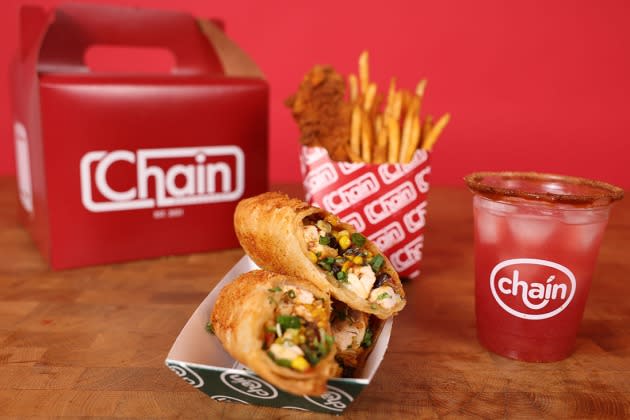
During a podcast interview in 2018, actor and foodie B.J. Novak teased an idea he had for a chain-themed restaurant that would, contrary to the fundamental business model of chain restaurants, consist of a single brick-and-mortar location. It would be a nostalgia play, drawing on a collective wistfulness for the menu items and now-kitschy aesthetic elements that define iconic, ubiquitous American food chains like Taco Bell, TGI Fridays, Outback Steakhouse, Chili’s and the like.
Two years of ideating later, by 2020, the COVID-19 pandemic (and the subsequent wave of outdoor dining) forced Novak and his team to pivot from their initial idea to start a sit-down restaurant in Los Angeles and instead launch temporary pop-ups in parking lots around the city in March 2021, with chef and Chain co-founder Tim Hollingsworth in charge of the rotating menu and kitchen. Since then, Chain has undergone a series of further evolutions. In its current iteration, the restaurant exists as a semipermanent outpost in an unassuming, rented home in Los Angeles (reimagined by Yellowstone and Nope production designer Ruth De Jong), a setup that marries the casual appeal of pop-ups with the advantage of stability (read: a fixed address).
More from The Hollywood Reporter
The food itself, of course, is in line with the concept’s theme. Hollingsworth cooks elevated versions of well-loved chain food items — such as Taco Bell’s crunchwrap supreme, Chili’s Southwest egg rolls and Outback Steakhouse’s bloomin’ onion — which are designed to taste just like their inspirations. His recipes are homages to the original dishes, and are released one meal at a time in “drops,” the term often used for new albums or sneaker releases, a process engineered to drive value up based on exclusivity and demand.
For more than a century, chain restaurants have helped bind Americans together, linking cities to suburbs and translating various cuisines for the tastes of the general public. Even as the internet segments society and digitizes communities, chain restaurants provide shared experiences that cut through distinctions of race, religion, gender, class and region. Though, in some ways, Chain’s VIP guests, high-end ingredients, long wait list and non-fast food prices make its audience more narrow. But the power of chain restaurants as shared cultural memory has proven to be a great equalizer.
“We talk a lot about the word Americana, which I think is synonymous with the ’50s, Elvis, Route 66 and diners. It’s a beautiful aesthetic, but for a different generation,” says film producer Nicholas Kraft, who, along with fellow producer Jack Davis, has helped conceptualize Chain and bring it to life. “What is new Americana? It’s chain restaurants. What the diner was in the ’50s to Americana, the Olive Garden out by the mall is to new Americana.”
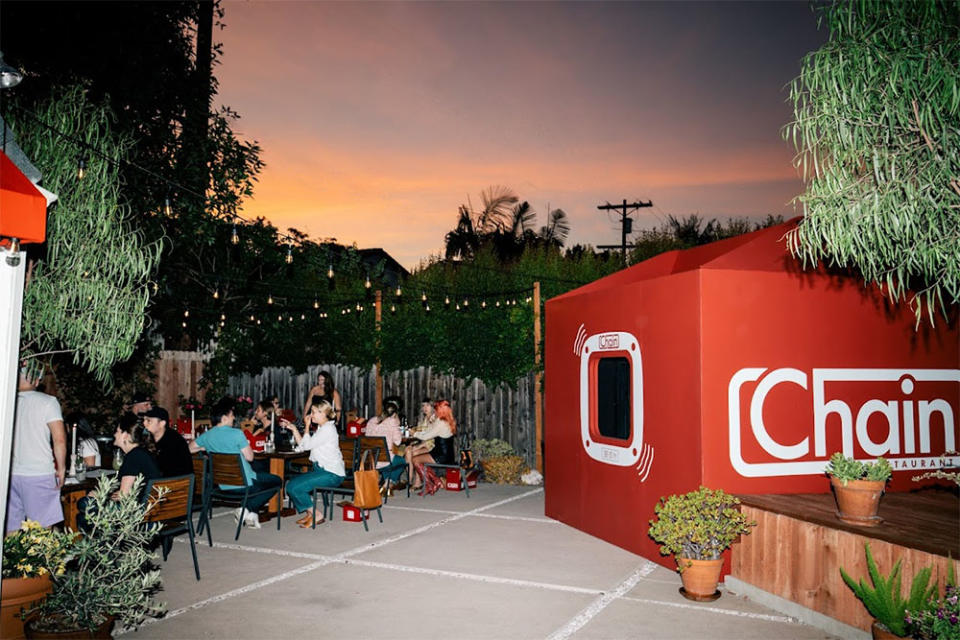
Chain has no menu and allows no modifications; only the night’s chosen meal is available. “[Pop-ups] were never supposed to be the product,” Kraft says. “But there was something so special about the communal meal, and only doing one item [each night]. It encourages everyone to have a conversation around their shared love of the dish.” When the world — and the doors of restaurants — started to swing open again, the team behind Chain wondered if the appeal of eating outside would diminish over time. So, in 2022, they began house hunting. (And began thinking about how to design the house, which they found in the fall of last year, in the style of a chain restaurant, too.)
“It seems counterintuitive if you’re going to do a chain restaurant, but so much of what chains are about is this neighborhood feeling,” Kraft explains of their choice to rent a regular home for commercial use instead of a traditional restaurant space. “I mean, literally, Applebee’s [motto] is ‘Eating good in the neighborhood.’ Olive Garden is ‘When you’re here, you’re family.’ A house kind of made sense.”
Chain’s head chef and co-founder Hollingsworth (who runs the kitchen at Los Angeles’ Otium, was previously chef de cuisine at The French Laundry and has been seen on Netflix’s The Final Table) says family dinners and date nights at chain restaurants were a special departure from home-cooked meals during his childhood and adolescence growing up in Texas, but that he then went a long time without eating at one as his fine dining career soared toward Michelin stars.
When Novak tapped him for this American casual gourmet dining concept, nostalgia immediately drew the chef in. “It really speaks to me because I read the menus of [classic chains] and get excited. It evokes this amazing feeling within me to think about the different dishes,” says Hollingsworth, whose favorites from Chili’s include the chicken tortilla soup, fajitas, egg rolls and chicken crispers. “I’m a person that goes to a restaurant and orders the same thing every single time. I go to a restaurant because I want one [specific] thing from them. And then I’ll kind of base an order around that.”
With Chain, Hollingsworth is committed to re-creating and elevating “the cult-ish dishes that people really latch on to, that are iconic for the specific restaurant and really speak to the brand that you’re working with,” he says. To this end, Chain has offered a take on Taco Bell’s crunchwrap supreme (which has become emblematic of the Mexican-inspired drive-thru’s broader menu), on McDonald’s McRib, and on Outback Steakhouse’s bloomin’ onion, among other classic New Americana offerings. Hollingsworth sources high-quality ingredients to make his own sauces (nearly indistinguishable from the originals) for the items, which come in a branded to-go box once they’re ready at the window.
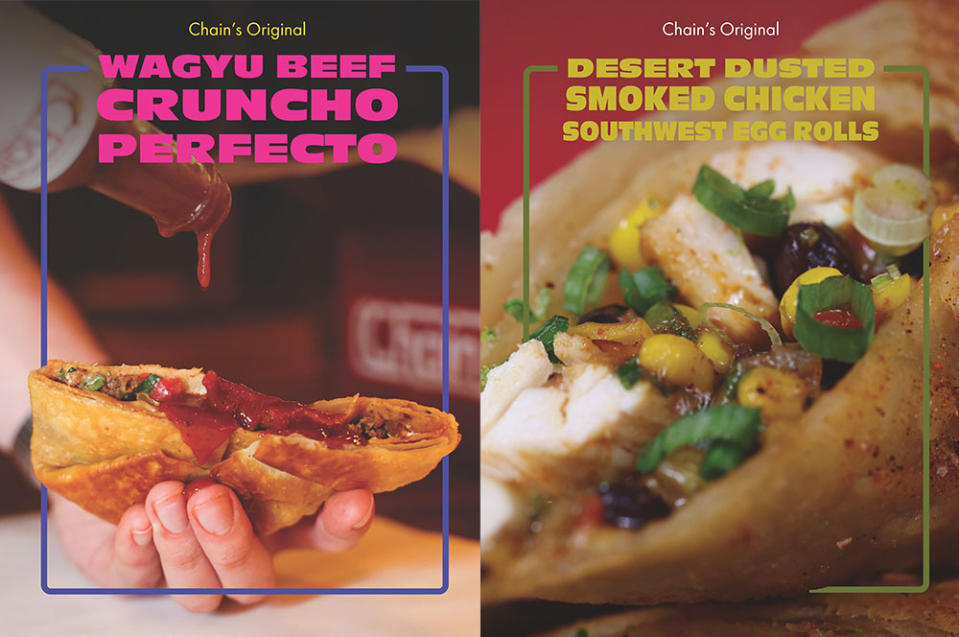
“What we’re really trying to highlight is just an appreciation for what [these restaurants] do,” he says. “The biggest thing for me right now is, when you taste the food, I want you to think of the restaurant in that nostalgic way, like, ‘This is what I remember’ … To me, the success is taking a bite and being like, ‘Wow, takes me back to Taco Bell.'” (By his own assessment, success was not immediate: The chef tested his crunchwrap supreme recipe more than 80 times before he was satisfied.)
Hollingsworth is not trying to create the most lavish, high-concept version of these items, but is instead going for honest replicas, subbing in ingredients like wagyu beef for whatever low-cost meat fast-food franchises might actually use, and dusting fried onions with nori and bonito flakes. “I think his genius is understanding what a dish is at its core, how an audience reacts to it, and he knows — because of his incredible pedigree — how to update it without warping what it is,” Kraft says.
The waiting list for the all-inclusive entry and meal tickets ($65), which are released in batches for designated time frames (guests receive a text alert when a reservation opens up) and capped based on the small kitchen’s availability to produce meals en masse, has reached 15,000 names — and counting. Hollingsworth says the amount of seats available varies, depending on that night’s given meal offering, because the demands of each featured item “really dictates the number of people that we can do.”
Since the experience of time-traveling back to a familiar, bygone era when eating in the Chain house is, on a psychological level, comforting, people tend to sit — and stay.
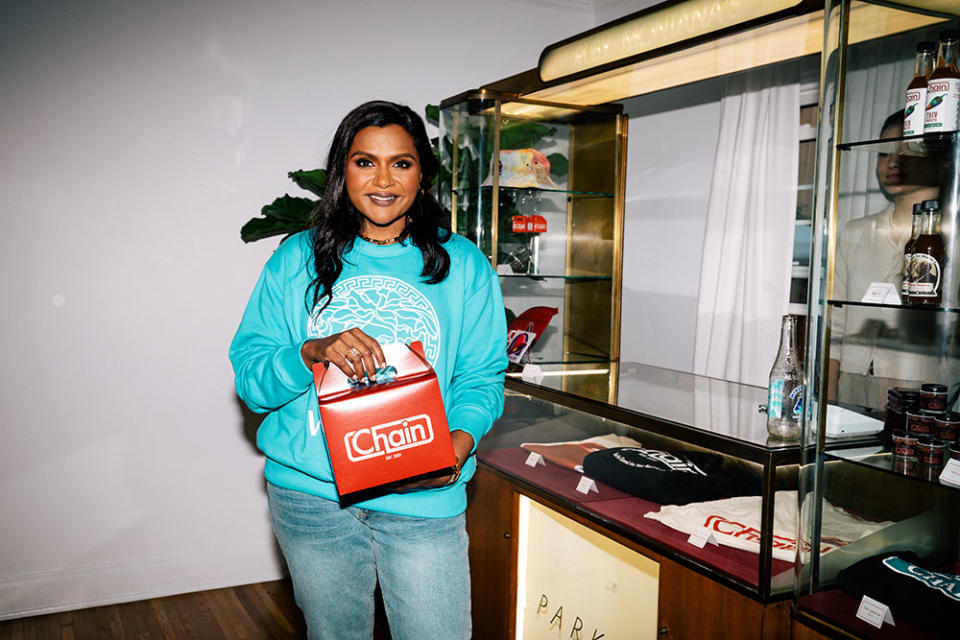
“Part of what we’re seeing is people come to the house and stay for two hours. And it’s not like it’s a multi-course meal — you get your food and you can finish in 20 minutes — but people enjoy the environment,” Kraft says, noting that without high turnover, capacity (which is roughly 50 seats) at any given time is a central consideration.
VIPs who have attended include Dakota and Elle Fanning, Chrissy Teigen and John Legend, Jen Atkin, Mike Rosenthal, Mindy Kaling, Kiernan Shipka, Elizabeth Olsen, Roy Choi and John Mayer (who designed the ‘Chain’ logo, inspired by a Best Buy newspaper circular from the early 2000s).
It was essential to Novak that the experience of eating at Chain be as visually transportive as film or television can be. In 2020, he called De Jong — the Emmy-nominated production designer behind Jordan Peele’s Nope and Us who designed sets for Yellowstone, Twin Peaks and Manchester by the Sea, among other credits — to ask if she’d take on a different type of project.
“The idea was: ‘Yes, we could hire an interior designer, but do they have a storytelling aspect that comes naturally?'” recalls De Jong, who was working on Christopher Nolan’s Oppenheimer at the time. “You want a restaurant with a story within a story within a story. I think that was cool — to dive into the initial research going back to the evolution of restaurants from the beginning of time, why they started and where they started and how they started. Similar to how I prep a movie, just researching the heck out of it and then deep diving into it.”
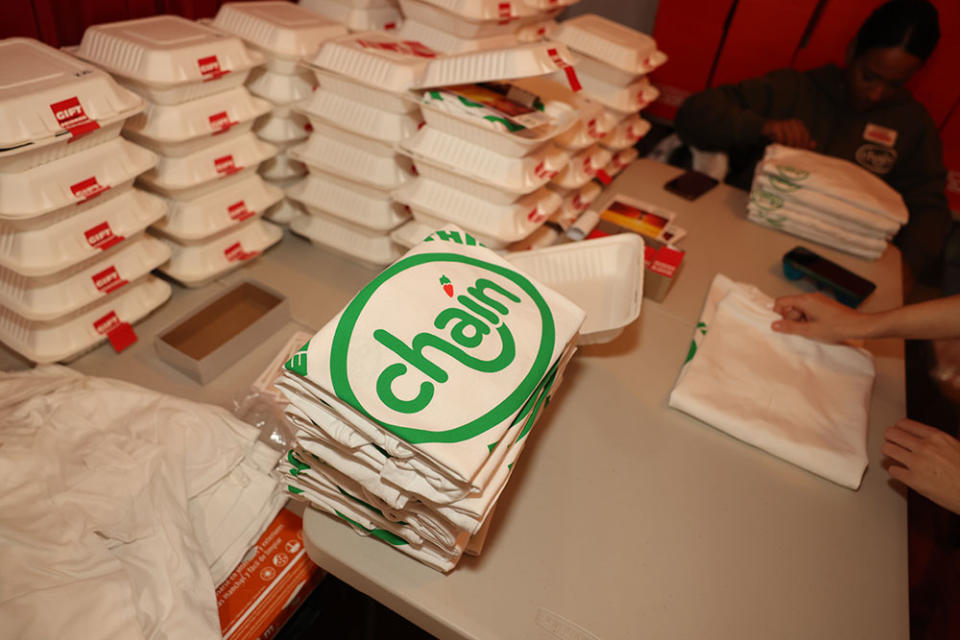
The “character” of Chain, as she calls it, evolved over the past couple of years. As part of the research process, De Jong, Novak and Kraft scouted “like every chain restaurant in SoCal [by] having lunch at all of them,” De Jong says. Once they landed on what exactly they were creating and what they wanted the definitive Chain experience to be, De Jong got started on crafting the set, otherwise known as a home on a tree-lined street.
“The house is simply a fun homage to every chain restaurant in America,” she says. “We were so tight on the narrative and the story and the script. We were constantly riffing on crazy things across all of Americana, because we’re always traveling with work and going to unique places and experiencing that.”
The assignment in many ways mirrored that of constructing a movie set. Both required working with a limited budget to create an immersive world that would eventually have to be dismantled — everything is temporary, because the house is a rental. (A “flagship” restaurant in a city like Las Vegas — ideally evocative of Americana with its iconic signage and historic connection to Route 66 — is likely on the horizon.)
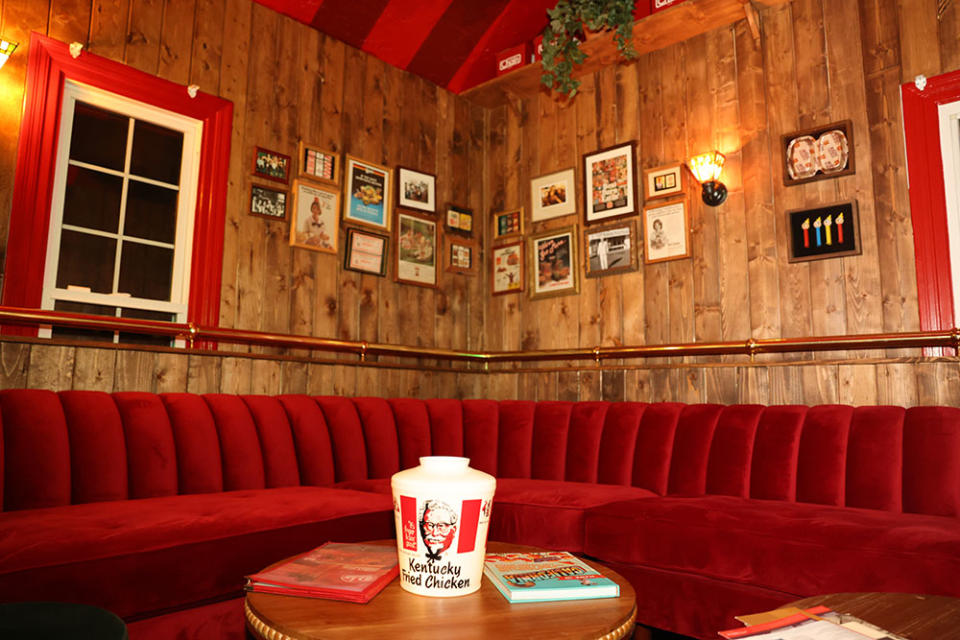
Retro eBay purchases added layers of authenticity. The space includes fixtures you might find glowing over a fast-casual pizza, a glass display case designed to present a Soup Plantation-like buffet (it in fact contains branded merchandise including bucket hats and T-shirts) and a KFC fried-chicken-scented fire log. (It helped that Kraft’s father is a committed collector of vintage restaurant mascots and other decorative memorabilia.)
“One thing we noticed: If you look at chain restaurants today in the 2020s, they’ve all gone to this very vanilla, banal [look]. They’ve tried to take away all character,” De Jong says. “The crazy Cheesecake Factories, TGI Fridays or Applebee’s are all stripping back to this so-called ‘modern’ or ‘contemporary’ [furniture], but it’s, like, all the same catalog. They’re just shopping different color schemes but there are no more tchotchkes.”
In order to collapse the vibe of all chain restaurants — different cuisines, yet existing in the same cultural and practical universe — into a single visual language for the house, De Jong looked to color. “The main thing that spoke to me was the specific color palette. We did a lot of paint samples and homed in on two specific colors that I felt were totally on point — the red walls and red velvet drapery — and then the wood paneling, because that represented so many places,” De Jong says.
Chain has reimagined several fan favorites including, most recently, the McDonald’s happy meal. Chain’s Scream VI-themed “Stabby Meal,” offered in partnership with Paramount Pictures and Spyglass Media Group to promote the upcoming release, comes complete with a bone marrow burger, fries, apple pie and toy (a collectible pin of one of the film’s characters). The dinner series has had one of its most successful, reoccurring collaborations with Chili’s, the restaurant known for its Southwest-inspired American favorites. Once Chili’s marketing team got wind of the concept and that Hollingsworth would be re-creating familiar favorites from their menu regardless, they decided to formalize the franchise’s relationship with Chain, by allowing Chain to reinterpret their logo and agreeing to cross-promote with their established audience, among other things.
“When B.J. and the team reached out to us about this opportunity, we thought it was an awesome way for us to give people a modern take on our Chili’s classics that everyone knows and loves,” George Felix, Chili’s Grill & Bar’s chief marketing officer, tells THR. “We had mutual trust and respect across our teams. On their side, I think Chili’s in some ways was kind of their North Star for this chain concept. And so it was mutually beneficial to both sides. I found it to be a really fun collaboration, and the credibility that they bring from a cultural standpoint is huge.”
Hollingsworth put his spin on Chili’s egg rolls (filled with smoked chicken) with a custom, but nearly identical blend of Tex-Mex spices and “desert dusted” seasoned curly fries. Felix, who previously worked in marketing at other iconic food chains like KFC and Pizza Hut, says working with a Michelin-starred chef like Hollingsworth is of particular value in a time when the everyday consumer is becoming increasingly more food literate, aware of quality ingredients and in search of a unique dining experience. “It’s exactly the type of thing we want to do to appeal to younger guests and this new, more educated foodie culture that’s out there.”
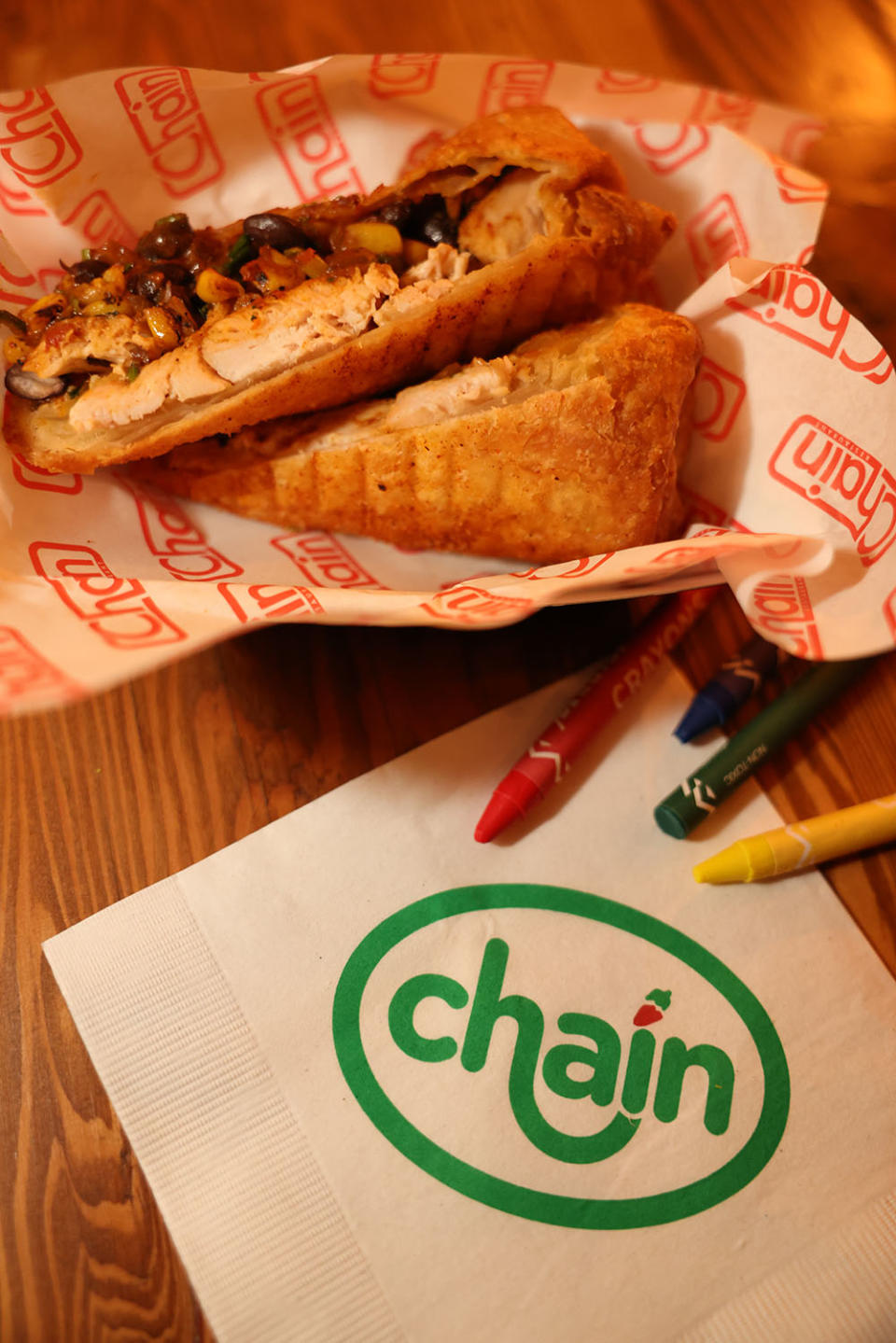
In a move that risked potential consumer confusion, Chain riffed on Chili’s’ well-known logo, adopting a similar typeface and color scheme, and even creating a neon sign for the Los Angeles bungalow destination with a kitschy chili pepper.
“Memory structures are super important, especially for iconic brands like Chili’s,” Felix says. “I think it’s about finding that balance where you don’t go completely retro for retro’s sake, but find those things that people know and love about your brand and kind of intersperse those with a more modern take.”
Sometimes, Chain takes the show on the road. Outside of the Los Angeles home location, the team plans to continue popping up to cater specific events, and hopes to have a presence at food festivals in the future.
“I feel like chains, specifically fast food restaurants, are having this moment right now,” Hollingsworth says. “It’s been some time since we started Chain, but now I’m seeing what McDonald’s is doing with all the branding and the collaborations. It’s really cool.”

